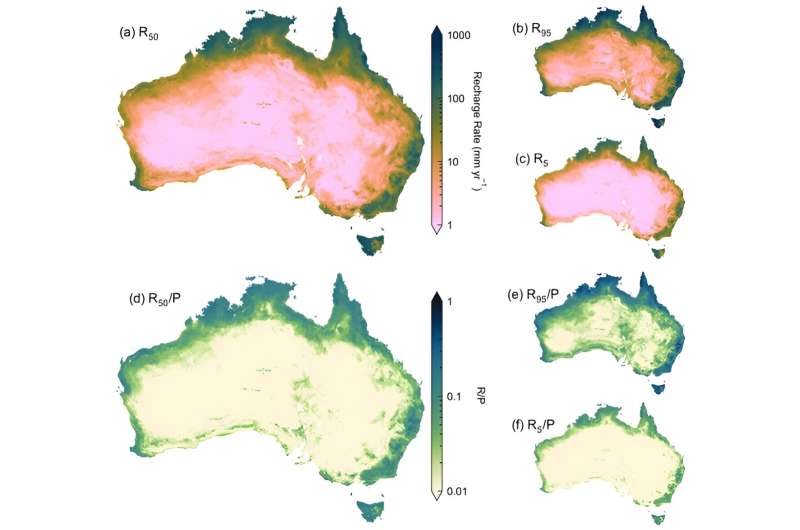This article has been reviewed according to Science X's editorial process and policies. Editors have highlighted the following attributes while ensuring the content's credibility:
fact-checked
trusted source
proofread
New study shows how quickly surface water moves to groundwater reservoirs across Australia

A new study from Charles Darwin University (CDU), Monash University and The University of Newcastle has presented almost 100,000 estimates of groundwater recharge rates across Australia, by far the largest known database of its kind.
Groundwater recharge is the rate at which groundwater resources are replenished by rainfall in millimeters per year (mm/y).
The recharge rates estimated for the Darwin area typically ranged between 150 and 420 mm/y, compared to values typically less than 2 mm/y around Alice Springs. In both cases, these values are only a fraction of the total annual rainfall.
The recharge rates estimated for the Beetaloo Sub-basin typically ranged between 1 and 50 mm/y, with an average of 16.5 mm/y.
CDU Ph.D. candidate and lead author Stephen Lee said the study used recently developed approaches to estimate recharge, and several existing datasets, aiming to aid water resource managers to improve their knowledge of how water interacts with and moves through the earth.
"Previous studies of global groundwater recharge have collated around 5,000 estimates, that were generated using a range of different methods, components, and durations of time," Mr. Lee said.
"This makes it a challenge to predict regional or global-scale recharge rates. In comparison, our study has used a single method to make consistent estimates of groundwater recharge in various Australian climates. We have created a map of these points that is now available to the public."
Researchers focused on chloride concentrations, a naturally occurring ion that is present in both fresh and salt water.
They generated a high-resolution model of recharge rates across climate zones in Australia, including arid zones in Western Australia where data has been limited.
"Our recharge rate estimates are notably lower than other studies, but we have provided more diversified coverage of arid areas, which make up most of Australia, whereas past studies were more focused on the tropics and temperate climates," he said.
"Along the east coast, higher rainfall and less evaporation due to temperate and tropical climates lead to higher recharge rates, and more dry, arid regions have less rainfall and lower recharge rates."
"For example, you can compare the Top End's low concentration of chloride in groundwater and high rainfall to high concentrations and low rainfall in Central and South Australia. Recharge rates generally increase the further north the area is."
Knowledge of groundwater recharge is vital for effective water resources management.
Mr. Lee said groundwater is vital for ecosystem survival, drinking water supply, agriculture, and other primary industries in the many areas where groundwater is the only reliable water source.
The findings also highlight that climate variables such as rain, seasonality, and potential evaporation from trees and vegetation significantly influence recharge rates.
"This study represents a significant step forward in groundwater recharge estimation," he said.
"We've used data that is often neglected, and we hope that by making it more accessible and interactive, the study will enable researchers and the water resource management industry worldwide to manage water resources better and mitigate the impacts of climate change."
Supervisor Dr. Dylan Irvine said the results could be used by researchers, government, industry, and the public to understand groundwater in their region.
"Despite its importance in water resources management, we can only estimate groundwater recharge," Dr. Irvine said.
"Here, we've provided the largest groundwater recharge dataset produced anywhere, and we've also produced a modeled map of recharge that can be used as a starting point in investigations where no recharge estimates are available."
The research is published in the journal Hydrology and Earth System Sciences.
More information: Stephen Lee et al, A high-resolution map of diffuse groundwater recharge rates for Australia, Hydrology and Earth System Sciences (2024). DOI: 10.5194/hess-28-1771-2024
Provided by Charles Darwin University


















